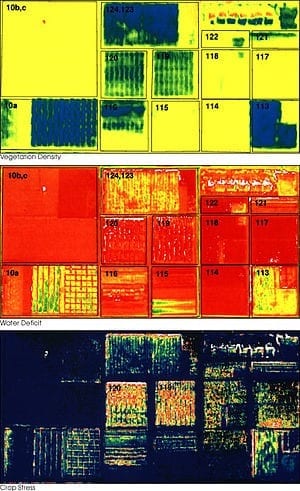
Technology Could Transform Games, But Applications Don’t Stop There
Researchers at Carnegie Mellon University and Disney Research Pittsburgh have devised a motion tracking technology that could eliminate much of the annoying lag that occurs in existing video game systems that use motion tracking, while also being extremely precise and highly affordable.
Called Lumitrack, the technology has two components — projectors and sensors. A structured pattern, which looks something like a very large barcode, is projected over the area to be tracked. Sensor units, either near the projector or on the person or object being tracked, can then quickly and precisely locate movements anywhere in that area.
“What Lumitrack brings to the table is, first, low latency,” said Robert Xiao, a Ph.D. student in Carnegie Mellon’s Human-Computer Interaction Institute (HCII). “Motion tracking has added a compelling dimension to popular game systems, but there’s always a lag between the player’s movements and the movements of the avatar in the game. Lumitrack is substantially faster than these consumer systems, with near real-time response.”
Xiao said Lumitrack also is extremely precise, with sub-millimeter accuracy. Moreover, this performance is achieved at low cost. The sensors require little power and would be inexpensive to assemble in volume. The components could even be integrated into mobile devices, such as smartphones.
Xiao and his collaborators will present their findings at UIST 2013, the Association for Computing Machinery‘s Symposium on User Interface Software and Technology, Oct. 8-11 in St. Andrews, Scotland. Scott Hudson, professor of HCII, and Chris Harrison, a recent Ph.D. graduate of the HCII who will be joining the faculty next year, are co-authors, as are Disney Research Pittsburgh’s Ivan Poupyrev, director of the Interactions Group, and Karl Willis.
Many approaches exist for tracking human motion, including expensive, highly precise systems used to create computer-generated imagery (CGI) for films. Though Lumitrack’s developers have targeted games as an initial application, the technology’s combination of low latency, high precision and low cost make it suitable for many applications, including CGI and human-robot interaction.
“We think the core technology is potentially transformative and that you could think of many more things to do with it besides games,” Poupyrev said.
Go deeper with Bing News on:
Motion Tracking Technology
- Silicon Motion Technology Stock: A Deep Dive Into Analyst Perspectives (11 Ratings)
Analysts have set 12-month price targets for Silicon Motion Technology, revealing an average target of $90.18, a high estimate of $110.00, and a low estimate of $85.00. Observing a 9.53% increase, the ...
- Silicon Motion Technology earnings: here's what to expect
Silicon Motion Technology is reporting latest earnings.Wall Street analysts predict earnings per share of $0.559.Track Silicon Motion ...
- West Police Department starts using motion sensor cameras to catch suspects on the road
The West police department has updated their way of tracking down the vehicles of suspects.With technology from Flock Safety, motion-sensor cameras will take pictures of any license plate that passes ...
- Motion captured: ‘Symphonic’ installation draws on movement of its visitors
Also a musician and assistant conductor of Yale’s Davenport Pops Orchestra, Schnyer set out to design an immersive installation that would use motion-capture technology to track visitors’ movements ...
- The Best VR Headsets for 2024
Virtual reality is a fascinating way to travel using nothing more than the power of technology. With a headset and motion-tracking technology, VR lets you look around a virtual space as if you're ...
Go deeper with Google Headlines on:
Motion Tracking Technology
[google_news title=”” keyword=”Motion Tracking Technology” num_posts=”5″ blurb_length=”0″ show_thumb=”left”]
Go deeper with Bing News on:
Motion tracking
- Eye Tracking Market to Hit Enormous Growth of 25.1% By 2033 | Rising Adoption of Eye-Tracking Technology
Eye tracking market size from USD 428.0 million in 2023 to USD 4018.0 million in 10 years. The rising adoption of eye tracking in virtual and augmented reality applications drives the market's growth.
- ‘This is not the time’: Trump on Greene’s failed motion to oust Speaker Johnson
G eorgia Rep. Marjorie Taylor Greene’s attempt to oust House Speaker Mike Johnson was quickly rejected Wednesday in a bipartisan vote.
- Kiwi start-up FTN Motion on track to rival Savic, Fonz
A Kiwi start-up which has designed an electric motorcycle able to carry up to five 6-packs in its centre console is looking to shift from across the ditch and rev up a storm in Australia.
- Motion captured: ‘Symphonic’ installation draws on movement of its visitors
Inspired by research findings of a “noisy universe,” a Yale senior used motion-capture technology to sculpt her own mini-universe of sound.
- This adorable motion-tracking camera is my go-to indoor security and pet camera
The is available for purchase at $130. With a dual-camera head, the S350 indoor camera has a telephoto and wide-angle camera, plus motion tracking abilities, with a 360-degree motion rate.
Go deeper with Google Headlines on:
Motion tracking
[google_news title=”” keyword=”motion tracking” num_posts=”5″ blurb_length=”0″ show_thumb=”left”]










